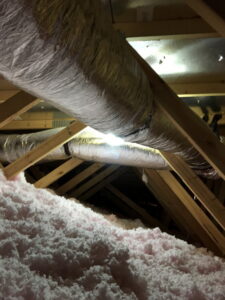Ductwork makes so much possible. It was first introduced around half a century ago to facilitate suddenly popular central air conditioning. Once so many homes had ducts, it only made sense to also use them for heating, and now forced-air furnaces are the most common heating systems in the country.
But everything, even if it’s a great plan overall, has the potential for problems. The problems ductwork is most likely to face are damage, caused by something specific, and deterioration, caused simply by time. Damaged or deteriorating ducts can have cracks and holes. What problems are created by duct leaks, and how can they be fixed? Read on to find out.
Types of Ducts
Not all ductwork is made of the same materials, and the different materials each have different advantages and disadvantages. Ducts made of sheet metal are the most expensive, but also the longest-lasting. Fiberglass or fiberboard ducts are less expensive but also less resilient. And flexible duct—wire coil covered in plastic—is the least expensive and works in confined places or around tight corners, but will deteriorate the fastest.
Leaks Let Air Out
When you’re paying good money to power your air conditioner or your heating system, the cold or hot air it’s creating is valuable. You want it to come streaming out your vents to keep your home at the perfect temperature. But with leaks in your ducts, that expensive heated or cooled air is able to escape. It might end up between your walls, or in your attic, where you don’t need it.
That hot or cold air is so precious and duct leaks are so common, Americans are spending a ridiculous amount of money heating or cooling air that goes nowhere. It’s estimated that in the average American home, so much air is leaking from ducts that 30% of energy used on heating and cooling is wasted.
Leaks Pull Air In
The other issue with tears or holes in ductwork is that the air pressure within the system can suck air into the ducts from those unoccupied places. Since your attic or the spaces between walls are filled with dust, sawdust, rodent droppings, insulation, and more, these contaminants get pulled into your HVAC system.
Particles like this are not good for your heater or your air conditioner. They get between moving parts and cause friction and wear and tear, and they clog your air filters, putting excess strain on the system. And the particles also get blown out your vents where you’ll end up breathing them.
Duct Repair
Despite the catchy name, duct tape is actually terrible at repairing ducts. Ductwork changes temperature constantly, and these fluctuations dry out the adhesive on the tape. Duct repair is perfectly straightforward, though, as long as it’s done by a qualified professional and a proper flexible sealant is used.
To find out whether you, like most Americans, have leaky ducts, inquire about duct sealing in Monroe, GA. We’ll be happy to improve your HVAC system efficiency and your air quality by repairing your ducts.
Reach out to Wall Heating & Air Conditioning, Inc. to make an appointment.

